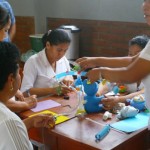 Almost a year ago to the day I attended a presentation at the RSA by Jos de Blok, where he spoke passionately about his nursing company Buurtzorg.
Almost a year ago to the day I attended a presentation at the RSA by Jos de Blok, where he spoke passionately about his nursing company Buurtzorg.
A major part of his philosophy was that the nurses on the frontline were often the best placed people to decide upon, and then implement changes to how they worked.
Attempts to develop groundswells of innovation are typified by projects such as NHS Change Day, which aims to empower frontline staff to make changes in their own work behaviors.
Suffice to say, the nature of many nurses work environment renders most of these changes very much of the behavioural variety. A new MIT led initiative aims to empower nurses to undertake more technical changes of their own volition too.
The maker movement and innovation
MakerNurse is a project that uses 3D printing technology to allow nurses to build their own fixes to challenges as they arise.
Over the past few years they have been cataloging ideas and innovations from nurses as to how the patient experience can be improved. It is now translating that into a prototyping and development process from its maker-space in the University of Texas’ Medical Branch hospital.
“We promised the nursing world that we’re not here to take your ideas. We want to develop tools,” the founders say. “Our dream was to make a medical maker space inside a hospital that was really suited for health care professionals.”
The site itself has much in common with other maker spaces, complete with 3D printers, laser cutters and a range of other digital fabrication facilities.
It also comes with facilities to add intelligence to the equipment, together with assembly tools to put it all together. There is also technical support on site to help turn the ideas from nurses into actual products.
Thus far, several hundred nurses have joined up, with numerous innovations already hitting the wards as a result.
Turning ideas into reality
Projects such as NHS Change Day highlight the vast amount of ideas and innovations in the heads of nurses around the world. Projects such as MakerNurse help these innovators turn their ideas into physical prototypes that can put their thoughts into action.
The digital fabrication process also supports the dissemination of such innovations, as each step of the production is documented and therefore easily repeatable.
Whilst it may sound like a bit of a Wild West, the team reveal that all innovations go through a very thorough infection control process before they get into any kind of clinical area.
I’ve covered similar innovations in this area, including the 3D printing of new medicines, and even 3D printed limbs to help train surgeons.
It seems that it might rapidly become essential for hospitals to have such fabrication facilities onsite to help deliver the kind of rapid innovations required to support a creative workforce.
Is it something that could find its way into all hospitals? Let me know in the comments below, and check out the video providing an overview of MakerNurse.
https://youtu.be/SJcBaskSsoQ
Interesting idea. I wonder how many nurses are confident enough (and have time) to use these facilities though?
Bet this would never take off in the NHS. Just imagine it.
Thanks for writing.